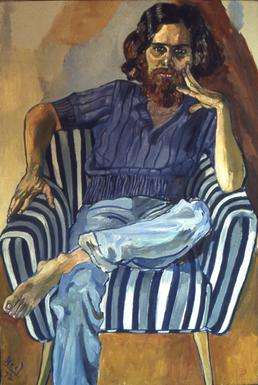Dana Gordon
Dana Gordon is a painting by Alice Neel, a 1972 portrait painted with oil on canvas depicting a man sitting in a striped chair. Little is known about this work in particular because it is not on display in a public museum or gallery but instead in a private collection, specifically the Alice Neel Estate.[1] However, details of the work can be inferred through comparison to her other paintings. This piece was painted in oil on either canvas or linen, as most of her paintings at this time were.[2] Neel rejected traditional portraiture and the aesthetic value that came along with it. She used people as an outlet to display the human condition and her own emotional and political journey. Due to her brutal honesty and interest in naturalism when depicting people, her style fell somewhere between expressionism and realism, as can be seen in the raw emotion and humanity she is able to capture in all of her paintings.[3]
| Dana Gordon | |
|---|---|
 | |
| Artist | Alice Neel |
| Year | 1972 |
| Medium | Oil on canvas |
| Owner | Alice Neel Estate |
Background
By 1972, Neel was nearing the end of her life and was living in New York City. 1972 also marked the beginning of the "New Right" in which conservatives reacted to the changes occurring through the Civil Rights Movement, the Feminist Movement, and the interest in the Communist Party.[4] Neel was a Communist for almost her entire life and her radical political views are apparent in who she painted and the way she painted them. Neel always chose to paint average, every day, and underrepresented people.[5] Dana Gordon depicts an everyday man, presumably of middle or lower class. He is not wearing any shoes and he looks tired, worn out, and dirty, the bags under his eyes emphasized through heavy shadowing. By painting him in this way she displays a specific side of his humanity. He appears as someone who has been beaten down by America's Capitalist and war-obsessed economy, as 1972 was three years before the end of the Vietnam War. The muted colors hint at the isolated existence this man lived, mirroring the feelings of someone beaten down by the unobtainable “American Dream.”
Formal qualities
In the piece, Neel utilizes color and line in order to communicate human emotion and the relationship between subject and environment within the artwork.
Neel uses color to depict the man in this beaten down and emotionally drained way. The man's shirt, paints, and chair are all painted in different blue colors while the man's hair and skin are of varying browns. The color palette is generally cool, giving the painting a somber and lonely tone. The lack of warmth emphasizes the lack of life within the subject. However, the skin and hair of the man are warmer in undertone, demonstrating the human emotion felt by the man despite his apparent lack of enthusiasm. The wall in the background of the piece is cream, brown, and blue, like the figure, tying together the subject in the foreground to the wall in the background and further emphasizing the connection of emotion and the relationship the subject has with his environment.
In addition to color, line is used in the painting in order to guide the viewer's eye. Lines are painted on both the man's shirt and the chair in which he is sitting, similarly to the motif of blue throughout the artwork. The striped blue chair featured in this painting is present in a number of Neel's artworks, tying her paintings together like a thread. Images with the blue chair present seem to denote that the object was commissioned by the subject or that the subject came to Neel's home to be painted. Her own self-portrait depicts her sitting in the same blue chair, indicating it as a piece of furniture in her home.[6] The lines on the chair lead the viewer's eyes up the subject to his face which holds the bulk of his humanity and apparent strife. As aforementioned, the man appears tired and worn down. His facial features most clearly exhibit this: his dark under-eye bags, his scraggly beard, his long, unkempt hair, and his wrinkled face. The lines she paints create a coherent flow from one aspect of the painting to another, further emphasizing the relationship between subject and environment. Soft lines are used in the wall to create a pattern, separating it from the foreground.
Purpose
This painting is not particularly different from her others; she largely painted portraits of people who she either knew personally or who commissioned portraits from her. Due to this portrait being named after the subject himself, the painting was most likely commissioned by the man for his own personal ownership, before being handed over to the Alice Neel Estate.[7][8] She painted both people and the political climate in which they were involved, as can be seen in the quote “I want my portraits to be specifically the person and also the Zeitgeist.”[5]
References
- Garb, Tamar; Lewis, Jeremy; Walker, Barry; Storr, Robert (2010). Alice Neel: Painted Truths. New Haven: Yale University Press. p. 20. ISBN 0300163320.
- Searle, Adrian (2010-07-07). "The weird world of Alice Neel". the Guardian. Retrieved 2018-06-13.
- Frances, Borzello (1998). Seeing Ourselves: Women's Self Portraits. New York City: Harry N. Abrams. pp. 88–87. ISBN 0810941880.
- "The 1970s". History.com.
- Meyer, Gerald (2014). Alice Neel: American Communist Artist. 13, no 2-3. American Communist History. pp. 179–188.
- "Alice Neel". www.artnet.com. Retrieved 2018-04-08.
- Alice Neel: the Woman & Her Work, exhibition 7 September - 19 October 1975. Georgia Museum of Art. 1975. p. 98.
- Georgia Museum of Art, Alice Neel: The Woman and her Work: 7 September – 19 October 1975, 98.